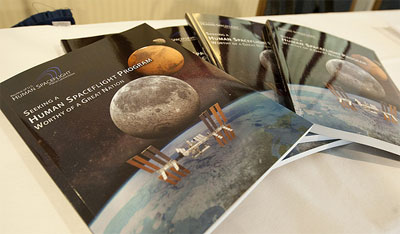All these worlds are yours, except the Moon and Mars (attempt no landing there)by Michael Huang
|
| The first thing that is interesting about the Flexible Path and the Program of Record are the names themselves. Whether it was unintentional or a conscious choice, the phrase “Flexible Path” is more appealing than the bureaucratic term “Program of Record”. |
One of Norman Augustine’s laws, “The optimum committee has no members”, goes well with the quip that “a camel is a horse designed by a committee”. The Flexible Path tries to satisfy everyone with a long laundry list of destinations, but it is more noteworthy for what it pushes back to the end of the line. The Program of Record (Vision for Space Exploration) has the objectives of manned landings on the Moon and Mars. The Flexible Path does the opposite—an anti-Vision—and tries to do everything except manned landings on the Moon and Mars. Lunar landings are replaced with lunar orbits, and Mars landings are replaced by Mars flybys and possibly Mars orbits. “Look but don’t touch” eliminates the servicing of surface equipment, in-situ resource utilization, and sample return for the Moon and Mars. Manned flights are two-way missions, so removing sample return is particularly short-sighted. The Augustine report includes part of a quotation from President Kennedy: “We choose to go to the moon. We choose to go to the moon in this decade and do the other things, not because they are easy, but because they are hard…” If the Flexible Path had been around during Kennedy’s time, all the Apollo landing missions would have been cancelled.
The Flexible Path attempts to replace the Ares 5, capable of lifting 160+ metric tons to low Earth orbit, with a less capable launch vehicle, going as low as the 75 metric tons of the EELV-derived vehicle. The notion that the Flexible Path brings us closer to Mars is dispelled by this push for a less capable launch vehicle. Being physically closer to Mars, in terms of distance, does nothing if it runs away from the energy and mass requirements of a Mars landing. The variety of missions possible using the Ares launch vehicles is actually wider and more diverse than what the Flexible Path allows. The Ares launch vehicles are certainly more than capable of launching missions to Lagrange points, near-Earth objects, and any other destination on the list. Reduced capabilities make the Flexible Path decidedly inflexible.
The Flexible Path replaces set destinations and set dates with a hazy cloud of uncertainty. NASA did not achieve Apollo like this. If the Flexible Path is as good as its proponents say, why will it be applied to human spaceflight exclusively? The entire space agency should have a chance to experience this new transformative policy. But with lesser objectives, lesser launch vehicles, and a lesser budget, it is unlikely the rest of the agency would enjoy the experience.
| Space policy rarely makes it as a national issue, but it is a strong local issue in key states and districts. “All politics is local”, even the politics of the Moon and Mars. |
This year’s committee is the second Augustine committee to deliberate on the future of NASA. The first committee in 1990 came to similar conclusions: scale back and downgrade human spaceflight, including the Moon-Mars expeditions (known then as the Space Exploration Initiative). Moon-Mars was killed during the 1990s, only to be revived by the current Vision for Space Exploration. It would be strangely historic if it is buried again by another Augustine report.
The second Augustine committee is also the start of the third Obama space policy. The first policy, almost a footnote in an education policy, planned to delay the Vision for Space Exploration by five years. That would push a lunar landing back to 2025. The second policy cancelled the five-year delay with the statement that Obama “endorses the goal of sending human missions to the Moon by 2020”. Obama went to the presidential election with that campaign pledge. Now, the Augustine committee has given the Obama administration a trigger for a third policy, if the administration decides to use it. But breaking campaign promises is not a good idea for politicians of any party. Space policy rarely makes it as a national issue, but it is a strong local issue in key states and districts. “All politics is local”, even the politics of the Moon and Mars.
